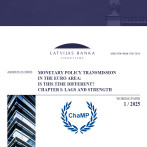The dynamics of money supply sustained despite the seasonal sluggishness in January
January of 2010 witnessed a small decrease in money in circulation, with the monetary aggregate M3 (the total amount of money in the economy, both cash and non-cash) declining by 1.1%, while the year-on-year dynamics of money supply remained unchanged. The negative annual rate of change of M3 improved to -2.3% in January (-2.8% in December). With the holiday season over, the demand for cash moderated somewhat in January (by 2.1%), and domestic deposits contracted by 1.4%; nevertheless, these indicators and money in circulation remained well above the levels of November 2009.
The domestic financial market remained stable and recorded a decline in lats deposits by a negligible 0.8%, whereas euro deposits shrank by 2.1%. The deposits of households and corporations decreased at a similar rate, whereas bank deposits received from non-residents continued their moderate increase. The annual growth rate of domestic deposits accelerated further and at the end of January corporate and household deposits with banks posted 104 million lats growth year-on-year.
Given the deteriorating quality of loan portfolios, banks' approaches to lending continued to be reserved; also, the domestic demand was low and the decline in lending to private sector persisted in January (-0.5%); yet, the fall was the smallest in the last four months. The growth of industrial credit portfolio by 0.6% was the most notable development in lending, a high since late 2008, and speaks of recognition of the business growth potential.
The seasonal decline in money supply is hardly an evidence of a deviation from the ongoing stabilisation trend in the financial sector, suggested by the positive dynamics of the year-on-year changes. In the months to come, considering the inflow of foreign funds, continued growth of exports and maintained stability in financial markets, further growth of money supply can be expected also in absolute terms. The expanding exports may trigger higher activity in lending, and the above increase in industrial credit recorder in January already points to that.
Textual error
«… …»






